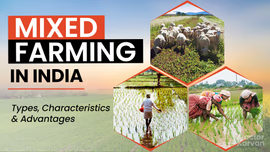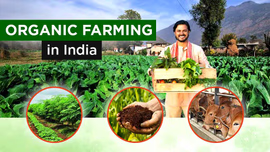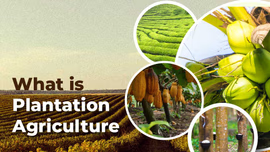Pomegranate Cultivation in India: How to Grow Profitably?

Pomegranate is a highly remunerative fruit with nutritional and medicinal value. Successful pomegranate cultivation requires adoption of best practices starting from land preparation to harvesting. Read this blog, to unravel the steps involved in pomegranate cultivation in India and the agro-climatic conditions required for cultivation of different varieties of pomegranates grown in the country.
Table of Contents
- Introduction
- Pomegranate Planting Season in India
- Why Pomegranate Cultivation in India is Increasing?
- Agro-climatic Requirements for Pomegranate Cultivation
- How to Successfully Grow Pomegranate in India?
- Economics of Pomegranate Cultivation in India
- Pomegranates Varieties Cultivated in India
Introduction
Pomegranate is an important fruit cultivated in the semi-arid and arid regions of India. It is highly resistant to heat, drought, and moisture deficit conditions. Besides, it has high nutritional and medicinal value.
Pomegranate is native to Iran, and India is the seventh largest producer of pomegranate globally, with the country producing 3 million metric tonnes in 2021-22 in an area of 2.75 lakh hectares. The area under cultivation is expected to increase to 7.5 lakh hectares by 2025.
Maharashtra is the largest producer of pomegranate in the country, with it contributing more than 50% of total production. It is followed by Gujarat, Karnataka, Andhra Pradesh, and Madhya Pradesh in the top 5 pomegranates-producing states. India is the only country in the world where pomegranate is cultivated throughout the year from January to December.
What is the Pomegranate Planting Season in India?
The pomegranate season in India starts with the propagation of pomegranate trees by air-layering during the rainy season and November – December period.
Planting is done in February – March in sub-tropical and July – August in tropical regions.
Depending on rainfall patterns, flowering can be induced three times a year, first, during June-July (mrig bahar); second, during September-October (hasta bahar); and third, January-February (ambe bahar).
Why the Pomegranate Cultivation in India is Increasing?
Pomegranate is a high-value crop, and its complete tree is of immense economic importance due to its medicinal value and its use in the dying and leather industry. Being a highly remunerative fruit crop, it has the potential to replace subsistence farming and ensure the sustainability of small holdings in the arid and semi-arid regions of India.
Pomegranate cultivation in India has increased in the last decade due to following reasons:
- The low maintenance cost combined with high yield and better storage quality of pomegranates in the country.
- Increase in the international demand for pomegranates has widened the scope for earning high returns. Some growers have demonstrated profits up to INR 1.5 lakhs per hectare per annum.
- The increasing consumer awareness about its health benefits has increased the demand for pomegranates in India.
- The decline in the productivity of high-value crops like apples due to climate change and water scarcity has forced the growers to shift to alternative crops like pomegranate.
What are the Agro-Climatic Requirements for Pomegranate Cultivation in India?
An arid ecosystem is best for successfully growing pomegranate as it can tolerate adverse soil conditions and the dry climate of such an ecosystem.
Soil
A wide range of soil types with a pH value up to 8.5 are suitable for pomegranate cultivation. It can grow even in soils with poor fertility and shallow depth with proper management and supply of essential nutrients. The best conditions for adequate fruit development and colour are:
- Soil: Light, well-drained sandy to loamy soil or alluvial soil
- pH value: 6.5 – 7.0
- Soil salinity: up to 6.00 ds/m
- Soil sodicity: up to 6.78 ESP
Climate
Pomegranates, due their hardy nature and wider adaptability, grow well in temperate, subtropical, and tropical climates. In temperate regions, pomegranates are deciduous, and in tropical and sub-tropicals, these trees are partially deciduous or evergreen. The best climatic conditions are:
- Climate: Semi-arid climate with hot summers and cold winters
- Temperature: - 11° C to 44° C
- Rainfall: 500 – 1000 mm
How to Successfully Grow Pomegranate in India?
Successful cultivation of pomegranates in India requires the adoption of best practices at every stage of cultivation starting from land preparation to harvesting. Let’s explore these stages of pomegranate cultivation briefly:
Land Preparation for Pomegranate Orchard
Before planting a pomegranate tree sapling, ensure that land is properly ploughed, harrowed and levelled two-three times to make the soil fine. Do ensure to remove weeds.
Planting of Pomegranates Saplings
Before planting the pomegranate saplings, you must ensure the following for successful fruit development:
Procure Quality Sapling
Procure a quality pomegranate sapling from a certified nursery because pomegranate trees propagated through stem cutting or air-layering are susceptible to diseases after 5 – 10 months of growth.
Adopt Best Propagation Method
Adopt tissue culture propagation as it has shown high success rate and are free from any kind of infection. Besides, it also aids in mass multiplication of pomegranate trees and are more suitable for mechanized cultivation.
Planting Method & Spacing
For pomegranate cultivation square or rectangular system of planting is the best. A pit of dimension 1m X 1m X 1m size is required for planting. The pit should be dug a month before planting and filled with topsoil and 20 kg FYM & 1 kg super phosphate.
Planting distance or spacing varies as per the soil, climate, and variety type. In general:
- Bhagwa Variety: Spacing of 4 X 3 m is optimum.
- Jalore & Ganesh Variety: Spacing of either 5 X 2.5 m, 5 X 4 m or 5 X 5 m is optimum.
- Light Soil: 4 X 5 m spacing is best.
- North India & Deccan Plateau: A spacing of 5 X 6 m is usually followed.
However, high density planting with a spacing of 2.5 X 4.5 m has been found to give 2 – 2.5 times more yield than the normal spacing of 5 X 5 m.
Nutrition Management
Nutrient management is critical for healthy growth of pomegranates in low fertile lands and arid regions of India. The specific recommendations on fertilizer doses per tree per year are:
- For 1 – 3-year tree: 600 – 700 g Nitrogen (N): 600 – 700 g, 200 – 250 g Phosphorus Pentoxide (P2O5): 200 – 250 g Potassium Oxide (K2O)
- For 5-year-old tree: 10 kg FYM and 75 g Ammonium Sulphate
- At the time of Flowering: 50 kg FYM, 3.5 kg Oil Cake and 1 kg Sulphate of Ammonia
The time of application is December – January, May – June and October – November.
Besides, application of micronutrients should be given in three foliar sprays during crop season.
Irrigation
While commercially producing pomegranates, irrigation should be in sync with crop growth stage. In pomegranate cultivation usually check basin system of irrigation is recommended. The specific irrigation requirement as per season is as under:
- Mrig Bahar crop: First irrigation in mid-May followed by regular irrigation till onset of monsoon.
- Summer crop: Weekly irrigation
- Winter crop: Irrigation at fortnightly intervals
However, drip irrigation has been found to be the most effective in pomegranate cultivation. An average annual irrigation of 20 cm through this system can help raise the yield by 30 – 35%.
Canopy Management
Canopy management in pomegranate cultivation is critical for balanced growth and development of fruits. It involves training and pruning of plants after 6 – 8 months of planting.
Training: A single stem or a multi-stem system can be followed. However, multi-stem system is more prevalent in India because plant trained on single stem are susceptible to pests like stem borer and shoot hole borer.
Pruning: Required for removal of water shoots, ground suckers, dead & diseased twigs and to give shape to the tree. A little pruning of old spurs is given to encourage growth of new spurs.
Inter-cropping
Inter-cropping with green manure crops, low growing vegetables, or pulses is beneficial during rainy season in arid regions, whereas inter-cropping with winter vegetables is feasible in irrigated areas. Moreover, inter-cropping needs to be practiced from 1 year up to 5 year when pomegranate orchard starts giving yield.
Flowering Regulation in Pomegranates
Pomegranate flowering season takes place in February – March (ambe bahar), July – August (mrig bahar) and September – October (hasta bahar). However, pomegranate plants flower throughout the year and bear small crop at regular interval in central and southern India. This is not desirable for commercial cultivation. To avoid this, flowering regulation or bahar treatment is suggested in following sequence:
- Two months prior to flowering: Withhold irrigation and apply ethrel (1-2 ml per litre) to facilitate shedding of leaves.
- 40 – 45 days after withholding irrigation: Light pruning of pomegranate trees and application of recommended fertilizer doses to profuse flowering and fruiting.
Plant Protection Measures
Measure against insects: Spraying pesticides like deltamethrin, dimethoate, or malathion etc to kill pests like mealy bugs, fruit borer, fruit sucking moths and white fly have been found to be effective.
Measures against diseases: Application of Kavach (2 gm per litre) and Carbendazim (1 gm per litre) during September – October for fruit rots and application of Mancozeb (2 gm per litre) for leaf spot is recommended during rainy season.
Measure against fruit cracking: Cultivating tolerant varieties such as Bedana Bose and Khog along with spraying calcium hydroxide soon after setting of fruits have been found to be beneficial.
Harvesting and Yield
Pomegranate is a non-climacteric fruit; thus, it should be harvested when fully ripe. Pomegranate plants take 4-5 years to come into bearing. Harvesting of immature or over mature fruits affects the quality of the fruits.
The fruits become ready for picking 120-130 days after fruit set. The calyx at the distal end of the fruit gets closed on maturity. At maturity, the fruits turn yellowish-red and get suppressed on sides.
What is the Economics of Pomegranate Cultivation in India?
Growing pomegranate in an acre costs around INR 1.75 lakhs. The pomegranate orchard starts giving yield from the 5th year onwards. The yield goes up from 4 tonnes/acre in 5th year to 7 tonnes/ acre in the 8th year.
Now, assuming that the yield is valued at INR 15,000 per tonne, the return increases from INR 60,000 (5th year) to INR 1.05 lakhs (8th year). Add to this, the additional income from inter-cropping of INR 30,000 assuming average yield of 6 tonnes/ acre and a cost of INR 10,000. The overall profit increases from INR 31,200 (5th year) to INR 68,800 (8th year).
What are Pomegranate Varieties Cultivated in India?
|
Variety |
Characteristics |
|
Ganesh |
Oldest variety, fruits medium sized, with yellow, smooth surface and red tinge, arils soft with pinkish color and sweet in nature. |
|
Jyoti |
Medium to large sized fruits with attractive, yellowish red, fleshier and pinker aril. Fruits are very sweet, soft seeded and taste good. |
|
Jalore |
Popular variety of Rajasthan, fruits round fruit, yellow with red tinge in colour, aril colour light pink to pink, juicy, taste sweet. |
|
Mridula |
Fruits medium sized, rind smooth, dark red in colour, blood red sweet arils with very soft seeds, plants are dwarf. |
|
Bhagwa |
Ruling variety of pomegranate in India, fruits big size, glossy red rind, thick rind, bold red arils, sweet and soft seeded, matures in 170 to 180 days after full bloom. |
|
Ruby |
It has soft and red arils with good flavour. The plants are dwarf, prolific bearer, providing uniformly red fruits. |
|
Amlidana |
Arils are highly acidic (4.8 %), fruit medium size, plant dwarf, suitable for anardana. |


Related Blogs












